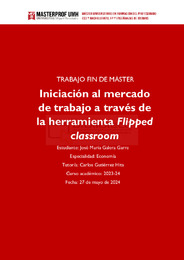Please use this identifier to cite or link to this item:
https://hdl.handle.net/11000/32924Full metadata record
| DC Field | Value | Language |
|---|---|---|
| dc.contributor.advisor | Gutiérrez-Hita, Carlos | - |
| dc.contributor.author | Galera Garre, José María | - |
| dc.date.accessioned | 2024-09-04T10:59:40Z | - |
| dc.date.available | 2024-09-04T10:59:40Z | - |
| dc.date.created | 2024-05-27 | - |
| dc.identifier.uri | https://hdl.handle.net/11000/32924 | - |
| dc.description | Especialidad: Economía | es_ES |
| dc.description.abstract | Ante las deficiencias encontradas en el modelo de enseñanza-aprendizaje tradicional, nacen las metodologías innovadoras con el fin de fomentar la autonomía por parte de los discentes. La herramienta Flipped classroom o aula invertida es una de estas metodologías, y es la escogida para el desarrollo de este trabajo fin de máster. En ella, se invierten los roles tradicionales, ya que los estudiantes adquirirán conocimientos en casa a través de recursos previamente seleccionados por el docente, como vídeos o lecturas, y luego profundizarán ese conocimiento en el aula bajo la guía del profesor. Los dos principales objetivos que se pretenden conseguir con este trabajo son: en primer lugar, realizar una revisión bibliográfica del aula invertida, en la que se expondrá el origen de esta metodología, cómo ha ido evolucionando y, finalmente, algunos ejemplos reales donde se ha llevado a cabo; en segundo lugar, se va a plantear una propuesta práctica en la que se va a desarrollar esta metodología con una situación de aprendizaje para la asignatura de “Formación y Orientación Personal y Profesional” del cuarto curso de la ESO. Por último, se presentarán unas conclusiones mencionando los beneficios de la utilización de esta metodología, así como sus limitaciones y una valoración final del conjunto del trabajo fin de máster | es_ES |
| dc.description.abstract | In the face of the deficiencies found in the traditional teaching-learning model, innovative methodologies are born with the aim of promoting autonomy on the part of the students. The tool Flipped classroom is one of these methodologies, and will be the one chosen for the development of this master's thesis. In it, the traditional roles are reversed, since students will acquire knowledge at home through resources previously selected by the teacher, such as videos or readings, and then deepen that knowledge in the classroom under the guidance of the teacher. The two main objectives of this work are: firstly, to carry out a bibliographical review of the inverted classroom, in which the origin of this methodology, how it has evolved and, finally, some real examples where it has been carried out will be presented; secondly, a practical proposal will be presented in which this methodology will be developed with a learning situation for the subject of “Personal and Professional Training and Guidance” of the fourth year of ESO. Finally, some conclusions will be presented, mentioning the benefits of using this methodology, as well as its limitations and a final evaluation of the Master's thesis as a whole | es_ES |
| dc.format | application/pdf | es_ES |
| dc.format.extent | 26 | es_ES |
| dc.language.iso | spa | es_ES |
| dc.publisher | Universidad Miguel Hernández | es_ES |
| dc.rights | info:eu-repo/semantics/openAccess | es_ES |
| dc.rights | Attribution-NonCommercial-NoDerivatives 4.0 Internacional | * |
| dc.rights.uri | http://creativecommons.org/licenses/by-nc-nd/4.0/ | * |
| dc.subject | Aula invertida | es_ES |
| dc.subject | Metodología de aprendizaje | es_ES |
| dc.subject.other | CDU::3 - Ciencias sociales::37 - Educación. Enseñanza. Formación. Tiempo libre | es_ES |
| dc.title | Iniciación al mercado de trabajo a través de la herramienta Flipped classroom | es_ES |
| dc.type | info:eu-repo/semantics/masterThesis | es_ES |

View/Open:
TFM Galera Garre, José María.pdf
1,1 MB
Adobe PDF
Share:
.png)
